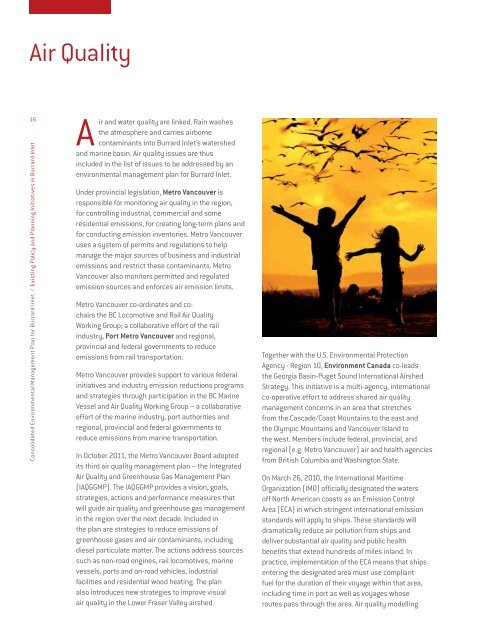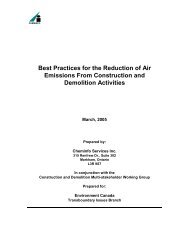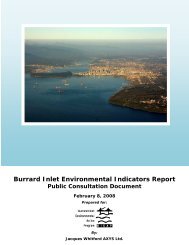Consolidated Environmental Management Plan for Burrard Inlet ...
Consolidated Environmental Management Plan for Burrard Inlet ...
Consolidated Environmental Management Plan for Burrard Inlet ...
You also want an ePaper? Increase the reach of your titles
YUMPU automatically turns print PDFs into web optimized ePapers that Google loves.
Air Quality<br />
16<br />
<strong>Consolidated</strong> <strong>Environmental</strong> <strong>Management</strong> <strong>Plan</strong> <strong>for</strong> <strong>Burrard</strong> <strong>Inlet</strong> / Existing Policy and <strong>Plan</strong>ning Initiatives in <strong>Burrard</strong> <strong>Inlet</strong><br />
A<br />
ir and water quality are linked. Rain washes<br />
the atmosphere and carries airborne<br />
contaminants into <strong>Burrard</strong> <strong>Inlet</strong>’s watershed<br />
and marine basin. Air quality issues are thus<br />
included in the list of issues to be addressed by an<br />
environmental management plan <strong>for</strong> <strong>Burrard</strong> <strong>Inlet</strong>.<br />
Under provincial legislation, Metro Vancouver is<br />
responsible <strong>for</strong> monitoring air quality in the region,<br />
<strong>for</strong> controlling industrial, commercial and some<br />
residential emissions, <strong>for</strong> creating long-term plans and<br />
<strong>for</strong> conducting emission inventories. Metro Vancouver<br />
uses a system of permits and regulations to help<br />
manage the major sources of business and industrial<br />
emissions and restrict these contaminants. Metro<br />
Vancouver also monitors permitted and regulated<br />
emission sources and en<strong>for</strong>ces air emission limits.<br />
Metro Vancouver co-ordinates and cochairs<br />
the BC Locomotive and Rail Air Quality<br />
Working Group; a collaborative ef<strong>for</strong>t of the rail<br />
industry, Port Metro Vancouver and regional,<br />
provincial and federal governments to reduce<br />
emissions from rail transportation.<br />
Metro Vancouver provides support to various federal<br />
initiatives and industry emission reductions programs<br />
and strategies through participation in the BC Marine<br />
Vessel and Air Quality Working Group – a collaborative<br />
ef<strong>for</strong>t of the marine industry, port authorities and<br />
regional, provincial and federal governments to<br />
reduce emissions from marine transportation.<br />
In October 2011, the Metro Vancouver Board adopted<br />
its third air quality management plan – the Integrated<br />
Air Quality and Greenhouse Gas <strong>Management</strong> <strong>Plan</strong><br />
(IAQGGMP). The IAQGGMP provides a vision, goals,<br />
strategies, actions and per<strong>for</strong>mance measures that<br />
will guide air quality and greenhouse gas management<br />
in the region over the next decade. Included in<br />
the plan are strategies to reduce emissions of<br />
greenhouse gases and air contaminants, including<br />
diesel particulate matter. The actions address sources<br />
such as non-road engines, rail locomotives, marine<br />
vessels, ports and on-road vehicles, industrial<br />
facilities and residential wood heating. The plan<br />
also introduces new strategies to improve visual<br />
air quality in the Lower Fraser Valley airshed.<br />
Together with the U.S. <strong>Environmental</strong> Protection<br />
Agency - Region 10, Environment Canada co-leads<br />
the Georgia Basin-Puget Sound International Airshed<br />
Strategy. This initiative is a multi-agency, international<br />
co-operative ef<strong>for</strong>t to address shared air quality<br />
management concerns in an area that stretches<br />
from the Cascade/Coast Mountains to the east and<br />
the Olympic Mountains and Vancouver Island to<br />
the west. Members include federal, provincial, and<br />
regional (e.g. Metro Vancouver) air and health agencies<br />
from British Columbia and Washington State.<br />
On March 26, 2010, the International Maritime<br />
Organization (IMO) offi cially designated the waters<br />
off North American coasts as an Emission Control<br />
Area (ECA) in which stringent international emission<br />
standards will apply to ships. These standards will<br />
dramatically reduce air pollution from ships and<br />
deliver substantial air quality and public health<br />
benefi ts that extend hundreds of miles inland. In<br />
practice, implementation of the ECA means that ships<br />
entering the designated area must use compliant<br />
fuel <strong>for</strong> the duration of their voyage within that area,<br />
including time in port as well as voyages whose<br />
routes pass through the area. Air quality modelling
















